Effects of ABC in Early Childhood
Effects of ABC in Early Childhood
Attachment
Among CPS-involved children, more of the children whose parents received the ABC intervention were classified as having secure attachments than those in the control group (52% of children receiving ABC vs. 33% of children receiving a control intervention). In addition, fewer of the children in the ABC intervention group had disorganized attachments than those in the control group (only 32% of ABC children were classified as disorganized vs. 57% of children in the control group) (Bernard, Dozier, Bick, Lewis-Morrarty, Lindhiem, & Carlson, 2012).
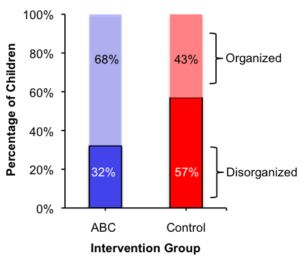
Cortisol regulation
Children who received the ABC intervention had a more normative diurnal pattern of cortisol production (steeper slopes and higher wake-up values of cortisol) than children who received the control intervention (Bernard, Dozier, Bick, & Gordon, 2015).
When assessed three years after completing the ABC intervention, children who received the ABC intervention continued to have a more normative diurnal cortisol pattern than the children who had received the control intervention (Bernard, Hostinar, & Dozier, 2015).
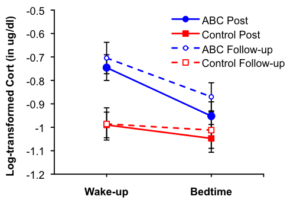
Self-regulation: Emotion expression
When children were between 24 and 36 months of age (1-2 years after the intervention), children participated in a challenging task designed to elicit frustration. Children who received the ABC intervention displayed less overall anger, and less anger towards their parents in particular, than children who received the control intervention (Lind, Bernard, Ross, & Dozier, 2014).
Attachment Self-regulation: Executive functioning & Inhibitory control
Between 4 and 6 years of age (2-4 years after the intervention), foster children who received the ABC intervention had stronger executive functioning and better inhibitory control than foster children in the control group. In addition, when looking at these skills, the foster children who had received ABC did not differ significantly from the comparison group of children who had never been involved with the foster care system (Lewis-Morrarty, Dozier, Bernard, Terraciano, & Moore, 2012; Lind, Raby, Caron, Roben, & Dozier, 2017).
More specifically, when asked to sort cards according to a particular dimension (e.g., shape) on the Dimensional Change Card Sort, children across both groups performed well. However, after being asked to change dimensions by which they were sorting (e.g., sort by color), children from the ABC intervention group showed significantly better performance than children in the control group. Being able to switch dimensions is associated with other executive functions, such as planning and inhibitory control, and deficits in executive functions are associated with disorders such as ADHD (Mulas et al., 2006).
Inhibitory control refers to the ability to inhibit a dominant (or pre-potent) response and instead behave in a different way that is appropriate to the circumstances. Inhibitory control is key to children’s success in preschool and kindergarten – indeed, it is more important than having emerging literacy and numeracy skills. For example, children need to sit at their desks (or in circle, etc.) and inhibit the impulse to jump up and look out the window as other children play outside. When they fail to have this ability, they are often identified as having behavioral problems.
We tested children’s inhibitory control in a challenging task. Children were shown an attractive array of toys, but asked not to touch the toys, but rather to color in a coloring book. Children whose parents received the ABC intervention showed better inhibitory control than children in the control condition. Fewer of the children in the ABC group touched the toys, and those who did touch the toys waited longer on average to do so than children in the control group (Lind, Bernard, Yarger, & Dozier, in press).
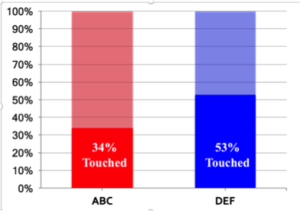
Verbal abilities
Foster children whose parents had received the ABC intervention had higher vocabulary scores (as assessed through the Peabody Picture Vocabulary Test: PPVT) than children whose parents had received a control intervention (Bernard, Lee, & Dozier, 2017). ABC children had a mean standard score of 98.1 (scoring at the 45th percentile) and children who received the control intervention had a mean standard score of 88.1 (scoring at the 28th percentile).
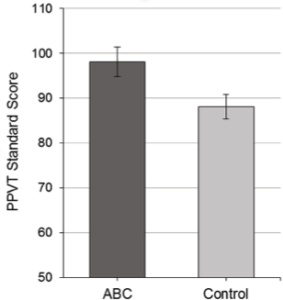
In an extension and replication of these findings with a different sample, we examined whether parental sensitivity mediated the effects of the ABC intervention on foster child language abilities. We found that the intervention had effects on children’s language abilities, and that this effect was fully mediated by parental sensitivity (Raby, Freedman, Yarger, Lind, & Dozier, 2018).
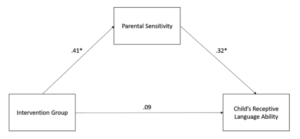
For more information regarding our references, please contact us.








